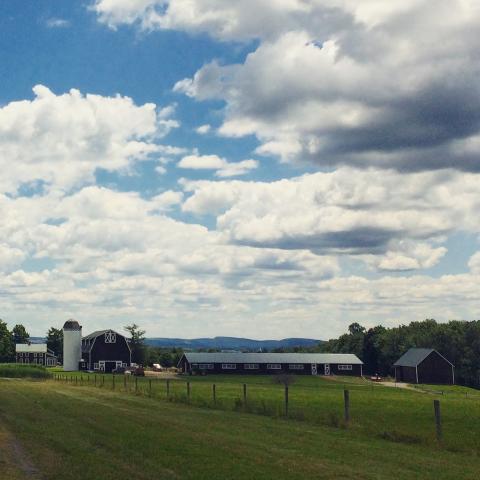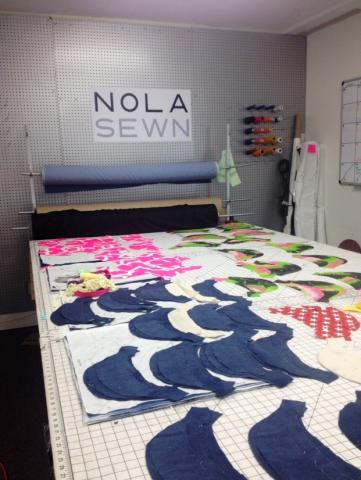Cheese Making: Hannah Grover ’16 at Meadowood Farms in Cazenovia, New York
Feb 10, 2016Working at Meadowood Farms for the past six weeks as the creamery intern has been enlightening, challenging, and full of new experiences. I didn’t quite know what to expect as I started this job, seeing as I had practically no cheese-making experience. It has been an exciting endeavor to learn something from the ground up with no practical knowledge of it—an experience which I have not received with my previous co-ops, because I at least had some related skill and understanding. Making cheese is a highly technical process, as well as an art. Veronica Pedraza, the head cheese-maker at Meadowood is an expert in her field and has been a wonderful teacher. However, more than learning about how to make cheese, I have learned a lot about taking pride in the work you do and always trying your absolute hardest to provide the client with the best product you possibly can.
Meadowood Farms is a sheep dairy which also raises prize winning, breeding cattle. On the farm, all animals are pasture-raised and carefully cared for. Besides making cheese, I have had the opportunity to work a bit on the farm, mostly helping with milking the sheep which happens at 4:30 am and 3:30 pm every day. To make great cheese, the quality of the milk is of upmost importance, so there are many precautions which are taken to make sure that all of the animals are healthy and that the buildings and equipment that are involved in cheese production are kept pristinely clean. Not being a complete neat freak, this aspect of the job has been a bit difficult for me to adjust to—we honestly spend more time cleaning and washing dishes than we do actually working with the cheese.
Many of the tasks which we complete, besides actually making cheese, involve flipping and caring for the cheese in the aging room and cave every day. Every cheese is cared for differently—some are washed with beer, brine, wine, or cider, others are salted, and others are punctured to create mechanical openings to allow mold to develop (think blue cheese). We make many different varieties of sheep’s milk cheese, but we also make some cow’s milk cheese using milk from a local farm. The varieties of cheese which are made at Meadowood vary from small soft cheeses wrapped in beer-soaked grape leaves (Ledyard pictured left) to harder cheeses (Ten Eyck).
Working at Meadowood has been an eye-opening experience, in terms of all of the technical and practical knowledge which I have gained about pastured-raised sheep and cheese making, and it has also been yet another co-op experience in which I’ve learned a great deal about myself and the way that I learn best. I am enjoying the challenge of being thrown into such a specific industry and learning it from the inside out—from milking the sheep, to making and caring for the cheese, to selling it at local farmers markets, I feel as if I am getting a profound and immersive experience of the lifecycle of cheese making at Meadowood Farms.
Textiles and Fashion: Grover ’16 at NOLA Sewn in New Orleans, Louisiana
Feb 08, 2016This co-op experience was exactly what I was hoping for and looking forward to when I first decided to come to Antioch College. I got the incredible privilege to live in a new, exciting place, to learn a lot about a subject area that I am intensely interested in, to meet many really fascinating and inspiring people, and to be part of an awesome company, doing work which I really cared about and enjoyed. I am grateful that I got the opportunity to live in the great city of New Orleans and work for Lisa Iacono at NOLA Sewn for the past three months.
During my co-op, I successfully completed my learning objectives, and on top of that, I learned an abundance of things beyond them as well. My first objective was to learn about the business side of fashion and production. While business is not necessarily where my main interests lie, I knew that it was such a big part of running a company like NOLA Sewn or any other one like it, so I knew it would provide valuable knowledge and skills for whatever I decide to do in the future. I learned all about varying aspects of business management and what goes into keeping a business running by doing organizational tasks for Lisa, learning her systems for making orders, billing, payments, and helping her prepare for sales appointments and other related things.
My second objective was to learn more about the design process. There is so much that goes into creating even one single piece of clothing, and I got to learn it all, from start to finish. I learned about the developmental process of a line, by helping with the assembly of inspiration and concept boards which help designers to find focus and to organize their thoughts behind their creative processes. A lot of design is a process of editing; creating a garment sample and then looking at it, deciding what works and what doesn’t work and how things can be fixed or changed to make them more wearable, more sellable, and easier to produce. I got to help with fittings, doing this type of problem solving and editing, which was one of my favorite experiences at my job because of how much creative and critical thinking is involved.
My third learning objective was to learn more about production and improve my skills with all the different tools found in a garment production facility, which I definitely got a lot of experience doing. Probably the majority of what I did at NOLA Sewn was work in the cutting room; which means laying and cutting fabric, dealing with patterns, and assembling tech kits for garments. Through learning how to do all of these tasks, I got to learn a lot about how fabrics differ from one another, how to find the grain of a fabric and why it’s important, and how to always keep your eyes open to try to catch mistakes before they happen.
This type of work takes immense concentration and focus, especially because of the tools which we used. For cutting through anywhere up to about fourteen layers of fabric at once, we used electric hand held knives which have spinning rotary blades on them, kind of like a heavy duty electric pizza cutter. These knives can be extremely dangerous if not used properly, which is why this work takes so much concentration. For bigger jobs of cutting up to sixty layers of fabric, Lisa would use the industrial table knife which is more dangerous and difficult to use than the small knives, but very efficient. I also got a lot more sewing experience (both hand-sewing and machine) under my belt than I had before, and I learned how to do other things like putting snaps and buttons on using various tools and machines. During my co-op, I worked with every part of the production process, so I definitely gained a lot of experience and got to improve upon some skills which I already had.
A moment when I felt really accomplished and proud of my work was at the fashion show for Lisa’s newest line, LIMOUSINE. I helped make sample gowns, assisted with marketing, populated the website, worked the photo shoot, helped to create specialty gowns for the runway, and finally helped put on the show which was during NOLA Fashion Week at the end of my co-op. I got to work a lot on the gowns for the runway show, with everything from helping pick out the fabrics we used for them, to cutting the samples, to adding hand-crafted details to make them extra special. One of the dresses which I got to cut was a beautiful couture wedding dress which was the finale of the show. I got to cut it out of vintage fabric from Paris which was seventy years old! It was so incredible to get to take a beautiful textile which was made in a completely different era and make something new and beautiful out of it; I felt like I was touching a piece of history. When I got to see those dresses walking down the runway, with camera flashes going off and people applauding, it was the most indescribable feeling. I, and everyone else at NOLA Sewn, did so much work on those dresses and everything related to them, so it was such an amazing thing to see them go out into the world with such a warm reception. I don’t think that I have ever felt prouder of any other work that I’ve done before in my life.
I learned so much about myself and the path that I want to be on during this co-op, which is what I am definitely most grateful for. I don’t think that I want to be a fashion designer, but I would love to work in a related field; perhaps costume design or textile design, or maybe in an art museum working with textile restoration or something similar. Through this co-op, I found that I am most happy and feel best when I am doing something tangible and hands-on, being able to see the direct results of my labor and time. I love the sense of accomplishment that this type of work gives me, and it’s something that I think I could be really good at (especially if I’m able to get more learning experiences at great workplaces like NOLA Sewn).
Throughout these first two years of college, I’ve been kind of stuck between two academic worlds, with interests in both social sciences (particularly anthropology) and the visual arts. Previously, I was thinking about doing a self-design major, but because of this co-op I have been very inspired to try to pursue a focus in 3-D visual arts. This co-op has allowed me to gain confidence in the visual arts and has let me see that I am very capable of being successful in this kind of field. It was just the push that I needed to decide to pursue what has always been what I’ve most enjoyed, but not always believed I could do. Working at NOLA Sewn, with such an aspiring mentor (who very generously offered me a job for after graduation if I want it!), has really been a more incredible experience than I could have ever imagined, and it has allowed me to learn so much about this field, myself, and what I want out of my life.



